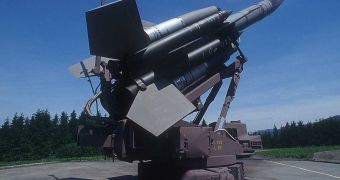Some missiles are accidentally damaged when struck by rocks and debris kicked up by helicopter rotors or when mishandled during shipping or maintenance.
Unlike missiles made of metallic alloys - which often show external signs of damage such as cracks or dents - damage in the new "filament wound" composite materials may not reveal obvious signs, said Douglas Adams, an associate professor of mechanical engineering at Purdue's Ray W. Herrick Laboratories.
The new monitoring system uses a mathematical model to pinpoint the location and severity of impacts based on vibration data collected by a sensor called a triaxial accelerometer that measures vibrations from three directions.
When engineers strike the casing at various points with a hammer, vibrations travel through the structure and are recorded by the sensor, and the data are used to fine-tune a mathematical model needed for the monitoring system. "We have shown that 98 percent of the time we can detect, locate and quantify the force of impacts," Adams said. "This information is very useful because it enables the monitoring system to determine within seconds whether an impact is beyond the design threshold and is great enough to likely cause serious damage".
The research focuses on the missile casing, made out of wound carbon fibers or Kevlar, a cylinder that holds the solid rocket fuel, and it has to withstand the high pressures created as the fuel burns.
The researchers are using a 15-foot-tall "impact tower" that rams a steel rod into the casing, simulating impacts from debris, tools striking the casing or mishaps, such as personnel accidentally dropping a missile, that can cause damage not detected by visual inspections.
In addition to detecting damage caused by an accident, the technique could also determine how durable the material is after long-term storage and exposure to the environment and how to design more impact-resistant casings in the future.
Research shows that some designs are more prone to damage because the force of impact concentrates on a small area. "You want a material system that distributes that impact load along many fibers so that no one fiber is carrying too much load, which could cause it to break," Adams said.
The more damage, the less pressure the casing can withstand before bursting.
Missiles made of the composite materials perform better than their metallic counterparts, the casings being up to 40 percent lighter, making them less expensive to ship and easier to handle and minimizing the risks of mishandling during the transportation and loading.
The same technique could be applied to commercial aircraft and spacecraft, as well as bridges, railways and other elements of America's aging transportation infrastructure.

 14 DAY TRIAL //
14 DAY TRIAL //